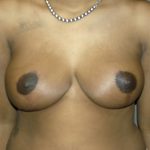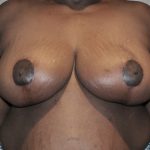Large breasts, known medically as macromastia, affects a significant percent of the female population. Last year, nearly 90,000 breast reductions were performed in the United States according to statistics from the American Society of Plastic Surgeons. Breast reduction surgery can not only offer cosmetic benefits (a breast lift) but medical benefits as well, relieving back and neck pain caused by the extra weight of larger breasts.

Scarring in patients with more skin pigment always has the potential to be more noticeable or worse for a variety of reasons. First, darker skin color means thicker skin with more dermis. The more dermis there is, the more collagen that is present to develop greater amounts of scar. Secondly, with more tissue cells that are available to produce pigment, the greater the chance there will be a hyperpigmentation (darker) reaction around the scar. The combination of both can create more noticeable scarring.
The common concerns about breast reduction is the fear of heavy scarring (hypertrophic scarring) or keloid scarring (pathologic scarring). Most patients use these two terms as if they were similar when, in fact, they are quite different. Hypertrophic (heavy) scars are a normal outcome in some patients, and reflect the body’s response to local tension on scars, the location of those scars, and the individual’s own genetic tendencies. Hypertrophic scars are limited to the area of injury, and are particularly prone to occur on the shoulders, knees, abdomen, breasts, and sternum. Keloid scarring is a genetically inherited disorder in which scars heal as if they were tumors, growing outside the confines of the original incision. Keloids are actually fairly uncommon and one will almost know if this is going to happen by having existing scars that have already developed this reaction. If an adult does not already have a keloid scar, it is not likely they will develop one from a breast reduction.

For those darker pigmented patients that have a morbid fear of scarring, some suggest that breast reduction using liposuction is another option to consider. This procedure offers minimal scarring and can alleviate back and neck pain caused by excess breast weight. While liposuction can reduce some breast volume and may be a consideration for a few select patients, it is not recommended for women who seek a lifting of the breasts as well. Since the breast lift component of a breast reduction is as important for most women as the volume reduction, liposuction alone is rarely sufficient.
Dr. Barry Eppley
Indianapolis, Indiana




